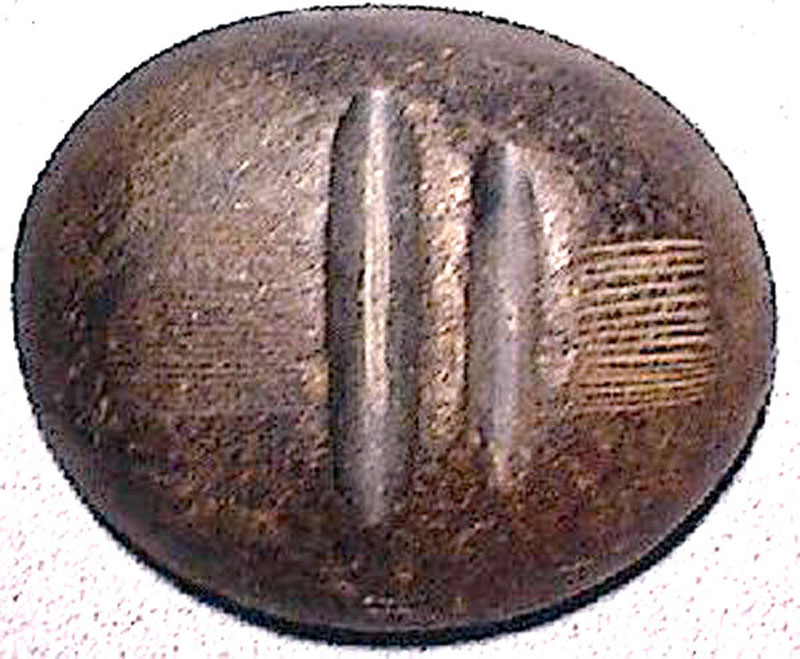|
|

|
At the western edge of the Mojave Desert, on the southern slope of the Tehachapi Mountains, halfway up a hillside overlooking an arroyo west of Rosamond where even the Joshua trees are dead, are the Burham Canyon pictographs (CA-KER-273). The central feature is a magnificent polychromatic panel on the underside of a granite outcropping with an abstract image in red, white, black, orange and a small amount of blue[1], together with anthropomorphic and possibly celestial figures. Barras[2] describes the feature as "the sun, moon, lines, circles and wheels" (1984:5). Also located at the site are granite boulders with as many as 50 cupules and deep bedrock mortars (up to 20 cm/8 in.). CA-KER-273 overlooks a less complex pictographic feature, CA-KER-1193 (not shown here), which is "comprised of a red sun-like symbol and about 30 short dashes" arranged in two rows, and which "may be associated with a possible winter solstice observation station" (ibid.). The sites are located within traditional Kitanemuk territory and are related to Willow Springs, once the largest Kitanemuk village in the northwestern Mojave Desert. The pictographs are a few miles northwest of the Willow Springs site (CA-KER-129). But CA-KER-273 was used not only by Kitanumuk women but also by Tataviam women from the southwest and Kawaiisu women from the northeast, who would go there to give birth, according to archaeologist Albert Knight, citing a 1990 interview with his Kawaiisu informant, Andy Greene. Greene also told him the women who came there used the abundant bitter brush, Purshia glandulosa, as a tonic, and they made use of all of the plants in the area (ibid.). Tataviam elder Charlie Cooke (1935-2013) reportedly corroborated Greene's statement[3]. According to Knight et al., Cooke said his father, Simon Dolores "Cy" Cooke, and one of his uncles, Isidoro "Izzy" Cooke, "used to take him there, and it was one of his father's favorite places." Also, Izzy Cooke was a friend of Andy Greene (ibid.). Charlie Cooke "has stated that the Burnham Canyon rock art sites ... are sacred to local Native American people and should not be casually visited" (Knight 1993).
1. Knight, Albert 1993: "Rock Art of the Western Mojave Desert: A Reevaluation." Journal of the Kern County Archaeological Society, Vol. 4: 41-60. Cited in "Rock Art of the Western Mojave Desert: A View from the First Decade of the 21st Century" by Albert Knight, Douglas H. Milburn and Barbara Tejada, Journal of the Kern County Archaeological Society, Vol. 4: 41-60, 2008. 2. Barras, Judy 1984: "Their Places Shall Know Them No More." Tehachapi: Judy and Bud Barras 1984. Note: The author refers to Burham Canyon by an alternate name, Tyler Horse Canyon. 3. Garfinkel, Alan P., and Harold Williams, "Handbook of the Kawaiisu," Wa-hi Sina'avi Publications 2011. Chapter 3 by Alan P. Garfinkel, Harold Williams, Albert Knight, Del Troy, David Earle and Mark Faull; and Chapter 7 by Albert Knight, Jack Sprague and Alan Garfinkel.
LW3302: Download larger images here. Photos by Leon Worden and Susan Shapiro, 6-3-2018.
|
Bowers Cave Specimens (Mult.)
Bowers on Bowers Cave 1885
Stephen Bowers Bio
Bowers Cave: Perforated Stones (Henshaw 1887)
Bowers Cave: Van Valkenburgh 1952
• Bowers Cave Inventory (Elsasser & Heizer 1963)
Tony Newhall 1984
• Chiquita Landfill Expansion DEIR 2014: Bowers Cave Discussion
Vasquez Rock Art x8
Ethnobotany of Vasquez, Placerita (Brewer 2014)
Bowl x5
Basketry Fragment
Blum Ranch (Mult.)
Little Rock Creek
Grinding Stone, Chaguayanga
Fish Canyon Bedrock Mortars & Cupules x3
2 Steatite Bowls, Hydraulic Research 1968
Steatite Cup, 1970 Elderberry Canyon Dig x5
Ceremonial Bar, 1970 Elderberry Canyon Dig x4
Projectile Points (4), 1970 Elderberry Canyon Dig
Paradise Ranch Earth Oven
Twined Water Bottle x14
Twined Basketry Fragment
Grinding Stones, Camulos
Arrow Straightener
Pestle
Basketry x2
Coiled Basket 1875
Riverpark, aka River Village (Mult.)
Riverpark Artifact Conveyance
Tesoro (San Francisquito) Bedrock Mortar
Mojave Desert: Burham Canyon Pictographs
Leona Valley Site (Disturbed 2001)
2 Baskets
So. Cal. Basket
Biface, Haskell Canyon
2 Mortars, 2 Pestles, Bouquet Canyon
|
The site owner makes no assertions as to ownership of any original copyrights to digitized images. However, these images are intended for Personal or Research use only. Any other kind of use, including but not limited to commercial or scholarly publication in any medium or format, public exhibition, or use online or in a web site, may be subject to additional restrictions including but not limited to the copyrights held by parties other than the site owner. USERS ARE SOLELY RESPONSIBLE for determining the existence of such rights and for obtaining any permissions and/or paying associated fees necessary for the proposed use.


































